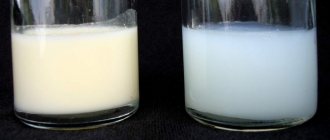Colostrum
It is a thick yellow liquid that resembles gruel or cream. This is the baby's first food. It is secreted from the breast in the first 4-6 days after birth in very small but sufficient quantities (depending on the capacity of the stomach, the digestive and excretory ability of the child). It is a nutrient rich in proteins, vitamins and, above all, antibodies. Antibodies are partially absorbed and largely remain on the surface of the child’s digestive system, protecting him from exposure to microbes. They play a role in preventing allergies and infections. Colostrum also contains prostaglandins, which protect the stomach.
Colostrum has a mild laxative effect and helps the baby pass his first stool, called meconium.
It differs from mature milk in the proportion of ingr.
dients. It contains several times more antibodies and less fat. It is a natural vaccine for the body of a newborn baby whose immune system has not yet developed.
Composition of colostrum:
- immune components: immunoglobulins (IgA, IgG, IgM, IgD), lactoferrin, oligosaccharides, lactalbumin, lysosomes, cytokines, polypeptides;
- nutrients: proteins, carbohydrates, minerals, vitamins, fats, energy components;
- growth factors: PDFG, IGF1, EGF, EVGF, TGF alpha, TGF beta.
1.Breastfeeding for beginners
This topic is very sensitive; mothers regularly think about how to give their baby complete breast milk, maximally enriched with nutrients. In modern medicine there is a huge amount of advice and debate about proper nutrition, complementary feeding and how much and when to feed a child. Inexperienced mothers sometimes find this process somewhat inconvenient and difficult. And stories about cracked nipples, continuous feeding and strict diets are completely frightening. Let's look at everything in detail and reassure young mothers. Undoubtedly, breast milk is the healthiest thing a baby receives in the first time after birth. And no mixtures, even very well selected ones, can compare with the amount of vitamins and nutrients that mother’s milk contains.
Of course, it is difficult to produce good breast milk just like that, without effort. Long before the baby is born, a mother needs to take care of her health, eat right and give up bad habits. After all, not only the quality of milk is also important, but also the quantity and duration of the lactation period. Be prepared for the fact that breastfeeding will last until the child is about two years old.
Composition of milk and mother's diet
The composition and quantity of milk depends little on the mother's diet. However, it should be varied and healthy, containing as few artificial additives (preservatives, enhancers) as possible. On the other hand, the exclusion of some products is unjustified. If your child does not have allergies, there is no need to eliminate potentially allergenic foods.
Did you know what colostrum is and why a child needs it in the first days of life?
When should you expect your breasts to fill with milk?
The body tends to initially fill with colostrum, since the lactation process allows breastfeeding.
Colostrum - The second product after milk is colostrum. When milk comes in after birth, a feeding schedule is set for the baby. An hourly schedule develops the body in the right way. It is no secret that lactation in women is associated with the appearance of tasty colostrum. The milk product is formed in the secretions of the mammary gland. The process of formation of colostrum and milk is individual. On average, the latest manifestation of colostrum occurs on the third day. If milk does not come after childbirth, do not immediately panic and come up with many reasons. Colostrum retention is not always a sign that a woman will never be able to breastfeed her baby. It does not always arrive on the baby’s first birthday.
What is transition milk?
1 Pang WW, Hartmann PE. Initiation of human lactation: secretory differentiation and secretory activation. J Mammary Gland Biol Neoplasia. 2007;12(4):211-221. — Pang W.U., Har. F Mammary Gland Biol Neoplasia. 2007;12(4):211-221.
2 Ballard O, Morrow AL. Human milk composition: nutrients and bioactive factors.Pediatr Clin North Am. 2013;60(1):49-74. — Ballard O., Morrow A.L., “Composition of breast milk: nutrients and biologically active factors.” Pediatrician Clinic North Am. 2013;60(1):49-74.
3 Munblit D et al. Colostrum and mature human milk of women from London, Moscow, and Verona: determinants of immune composition. Nutrients. 2016; 8(11): 695. — Moonblit D. et al., “Colostrum and mature breast milk of women in London, Moscow and Verona: main factors of immune composition.” Nutrients. 2016; 8(11): 695.
4 Pons SM et al. Triacylglycerol composition in colostrum, transitional and mature human milk. Eur J Clin Nutr. 2000;54(12):878-882. — Pons S.M., “Triacylglycerol in colostrum, transitional and mature human milk.” Yur J Clin Nutr. 2000;54(12):878-882.
5 Neville MC et al. Studies in human lactation: milk volumes in lactating women during the onset of lactation and full lactation. Am J Clin Nutr. 1988;48(6):1375-1386. — Neville M.S. et al., “Female Lactation Study: Milk Quantity in Lactating Women at the Beginning and Peak of Lactation.” Am F Clin Nutr. 1988;48(6):1375-1386.
6 Kunz C, Lönnerdal B. Re-evaluation of the whey protein/casein ratio of human milk. Acta Paediatr. 1992;81(2):107-112. Kunz S, Lonnerdal W. Acta Pediatr.1992;81(2):107-112. — Kunz S., Lönnerdahl B., “New assessment of whey protein/casein content in breast milk.” Acta Pediatrician. 1992;81(2):107-112.
7 Martin CR et al. Review of infant feeding: key features of breast milk and infant formula. Nutrients. 2016;8(5). — Martin S.R. et al., “Overview of Infant Feeding Issues: Key Features of Breast Milk and Infant Formula.” Nutrients. 2016;8(5).
8 Lönnerdal B et al. Longitudinal evolution of true proteins, amino acids and bioactive proteins in breast milk: a developmental perspective. J Nutr Biochem. 2017;41:1-11. — Lönnerdahl B. et al., “Longitudinal evolution of true proteins, amino acids and biologically active proteins of breast milk: developmental perspectives.” J Nutr Biochem. 2017;41:1-11.
9 Casey CE et al. Studies in human lactation: zinc, copper, manganese and chromium in human milk in the first month of lactation. Am J Clin Nutr. 1985;41(6):1193-1200. — Casey S.I. and co-authors, “Female lactation study: zinc, copper, magnesium and chromium in breast milk in the first months of lactation.” Am J Clin Nutr. 1985;41(6):1193-1200.
What are the benefits of colostrum?
Colostrum, firstly, is very nutritious, secondly, it is very fatty, and thirdly, it carries elements of immunological protection that the mother passes on to the baby with her breast milk so that he becomes immune. And obvious immunity, which the baby himself will develop to protect against all kinds of microbes, appears only by six months. Therefore, if a mother begins to feed colostrum from the first minutes of the baby’s life and continues until milk comes in, she thereby lays the ideal immune base for the future health of the child. Colostrum is so beneficial that you should never express it.
From the third or fourth day, the young mother begins to feel a surge of milk. This manifests itself in swelling of the mammary glands, painful sensations in the nipples, and often an increase in temperature to 37.5 degrees. During this period, it is very important to closely monitor your breasts and your condition. Too high a temperature, fever, or vice versa - a feeling of cold, too hard breasts - all this indicates that you need to express milk. In addition, with the appearance of milk, breastfeeding becomes the main task of the mother. Of course, a newborn baby is not able to cope with pumping his mother’s breast on his own - he does not need a large amount of milk. That is why doctors recommend expressing milk by hand or using a breast pump after each feeding.
What does breast milk look like?
La Leche League
original article https://www.llli.org/russian/FAQ/milkcolor.html
Women's milk is hidden deep in the breast, but people are curious creatures, so many women express milk to see what it is like. Naturally, few non-specialists know what ordinary human milk should and can look like. However, this does not prevent mothers from making far-reaching conclusions about the quality of milk and its effect on the child’s condition based on a visual assessment. “I had such poor milk - blue and completely transparent” or “My milk was as fat as cream. Because of this, the baby’s stomach hurts.” Have you heard similar comments? Such sudden and unfounded conclusions can even lead to a refusal to feed!
Whatever milk you have in your breast, rest assured that it is the most necessary and correct milk in the world. Every mother produces milk that suits her baby. Moreover, breast milk, like a chameleon, changes all the time. The composition of milk changes during one feeding. First, the baby sucks out the more watery, bluish-looking “front” milk, and by the end of feeding the baby sucks up the fattier so-called “hind milk” (see illustration* - “front” milk on the left, “hind” milk on the right) .
Milk changes as the baby grows, meeting the needs of the growing body. If a mother or child gets sick, new components appear in the milk - immune factors that either protect the child from the disease or even help prevent it. The composition and color of milk may change slightly depending on the mother’s nutrition, preparing the baby for adult complementary feeding. Research shows that breastfed babies are more receptive to the taste of a variety of foods, unlike formula-fed babies who eat formula with the same flavor.
The composition of foods and drinks that a nursing mother consumes can give milk a wide variety of shades. For example, the milk of a mother who eats a lot of yellow vegetables (carrots, pumpkin, sweet potatoes, yams) contains a lot of carotene, which turns the milk yellow or orange. Carotene is absolutely harmless for children (see the “Questions and Answers” section about carotenemia “My child’s skin has become yellow-orange in color...”). One of the La Leche League leaders, who worked part-time at a breast milk bank, said that bank employees could accurately determine by the color of the milk what kind of lemonade the donor mother drank.
The article “General Recommendations for Storing Breast Milk” talks about what color milk from a particular food may be.
“If the mother’s diet contains carbonated or fruit drinks, dessert jellies, then food additives and coloring agents can change the color of the milk to pink or pinkish-orange. Greenish milk may mean that mom drank drinks with green dyes, ate seaweed or green vegetables in large quantities. One woman taking a certain prescription drug reported that her milk was black. Frozen milk may be yellowish in color.
Pinkish milk may also mean that blood has leaked into it. Cracks in the nipples often give the milk a pinkish tint, but blood may appear in the milk even if there are no cracks. If you think the blood in your milk is from cracked nipples, contact a La Leche League leader. The leader will advise you on how to heal cracked nipples. Blood in milk is not dangerous for the baby, and you can safely continue to feed. Contact your doctor if blood is still present in your milk two weeks after delivery."
*********************************************************************************************
During lactation, the composition of milk constantly changes and directly depends on the requirements of the baby’s growing body. Breast milk composition differs not only from different mothers, but also from the same woman at different ages of the infant. Over the course of one feeding, the composition of the milk also changes. At the beginning of feeding, the baby receives foremilk (early milk) . It has a bluish tint, watery, rich in proteins, lactose, vitamins, and minerals. Foremilk completely satisfies the baby's need for drinking. Contains up to 90% water, therefore, if the baby is exclusively breastfed, he does not need to supplement with water even in hot climates.
At the end of feeding, the baby receives hind (late) milk . It is white in color, thicker, and contains more fat than foremilk. It is hind milk that causes the baby to feel full. For growth and development, it is very important that the baby receives both fore and hind milk. If a baby who sucks slowly is taken off the breast prematurely, he will lag behind in height and weight. The colostrum period is characterized by the production of the first milk - colostrum. It begins immediately after birth and lasts 3-4 days. The duration of this period, as well as other periods, is individual for each woman.
Colostrum is yellowish in color, thicker than mature milk, and tastes like amniotic fluid. This is the only perfectly balanced nutrition that meets the specific needs of the newborn body. Colostrum contains little fluid, which protects the newborn's immature kidneys from overload. It has a laxative property and helps the baby to easily excrete the original feces - meconium. Colostrum contains substances that promote rapid maturation of the baby's undeveloped intestines. Colostrum is extremely rich in immune factors - antibodies and leukocytes, which are the first immune defense for the newborn. The level of protective factors in colostrum is so high that it can be considered not only as a food product, but also as a medicine.
Physiological features of this period:
- a woman's breasts are soft; no feeling of milk flow, no breast swelling
- Colostrum is secreted in very small quantities, but this is enough for a newborn.
- During this period, the child is allowed to stay at the breast almost 24 hours a day (if he requires it), because The baby will receive nutrition literally drop by drop.
The period of lactation formation begins with the arrival of transitional milk (~ 3-5 days after birth), is replaced by the production of mature milk (~ 10-15 days after birth) and lasts on average 6-8 weeks. The duration of this period is very individual for all women. In terms of timing, it approximately corresponds to the period of newbornhood and the adaptation of the newborn to new conditions of existence.
Transitional milk replaces colostrum and gradually turns into mature milk. Mature milk is opaque, whitish and thinner than colostrum. It also contains all the necessary substances for the proper growth and development of the baby.
This period is characterized by peaks in milk flow. The arrival of milk is accompanied by swelling of the breast, a feeling of heaviness and pain. Sometimes high tides can be accompanied by rising temperatures. Due to the fact that this period corresponds to the adaptation of the newborn and the formation of self-regulation of lactation, it is at this time, most often, that a woman faces the main problems of breastfeeding (cracked nipples, lactostasis, mastitis, lactation crises).
The period of mature lactation begins after the lactation process has improved, includes the stage of introducing complementary foods and, gradually, with the stage of weaning, moves into the period of fading lactation. This period will last as long as the mother breastfeeds the baby.
After lactation begins, the mammary glands become softer, but the amount of milk does not decrease. On the contrary, with frequent feeding of the baby to the breast, the amount of milk increases according to the needs of the baby.
The period of extinction of lactation begins with the stage of weaning and ends with the complete extinction of lactation.











